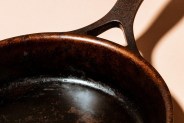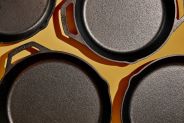Not much has changed about the humble cast-iron skillet over the last 100 or so years. When the cookware returned to popularity about a decade ago — thanks largely to the flavors it can impart on one’s food — it did so with similarly weighty builds, stellar heat insulation, pour spouts, a handgrip opposite the handle and a ring around the base of the pan. Unlike other, flashier cookware, cast iron remained a utility-first venture … except for that ring.
It’s Called a “Heat Ring”
The ring on the base of the cast-iron skillets is called a “heat ring” — though some historians refer to it as a “smoke ring.” According to Dennis Powell, founder of cast-iron cookware maker Butter Pat Industries (now owned by Yeti), it’s really a “machining ring.”

“Machining rings are used to remove material and make a surface flat without machining a wider surface,” Powell explains. “Flatness has always been a casting issue for large, thin surfaces. Machining rings solve them easily.”
The History of Heat Rings
Powell, who has spent years studying cast iron design and manufacturing documents in the Library of Congress, says the earliest records show it was called a machining ring before companies realized they could market it as a feature.
In other words, the heat ring is a defect disguised as a feature.


